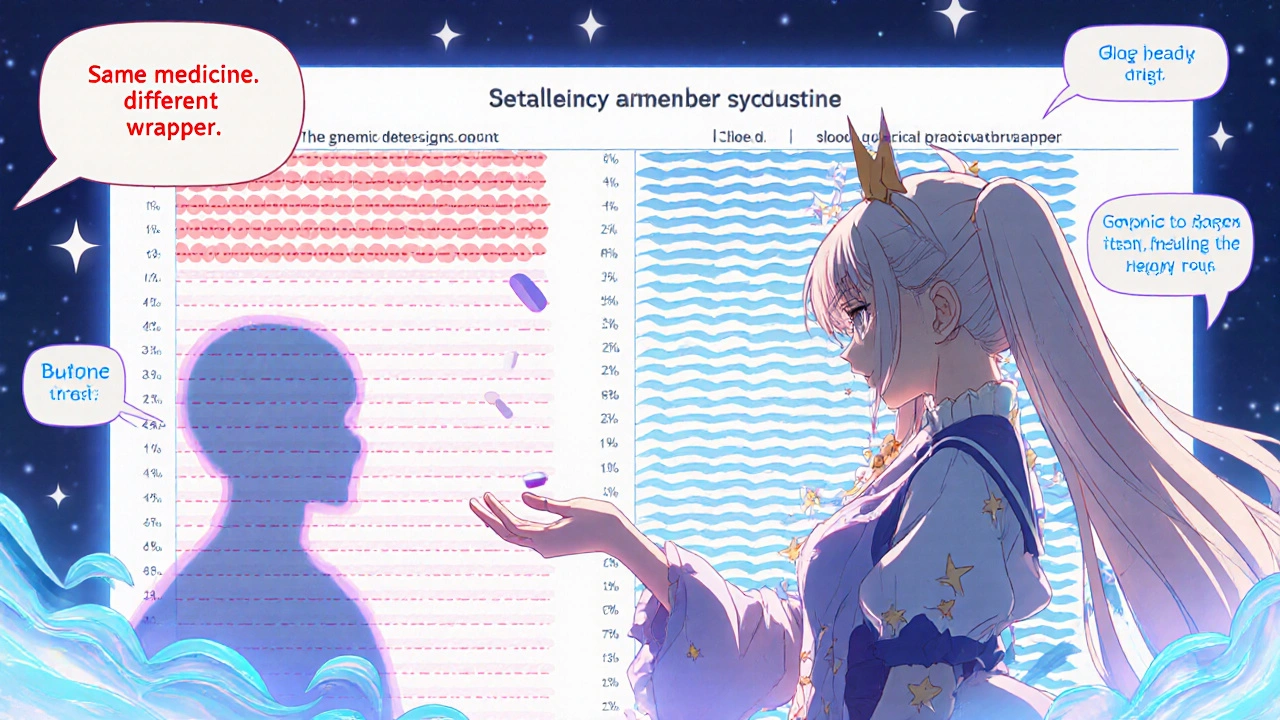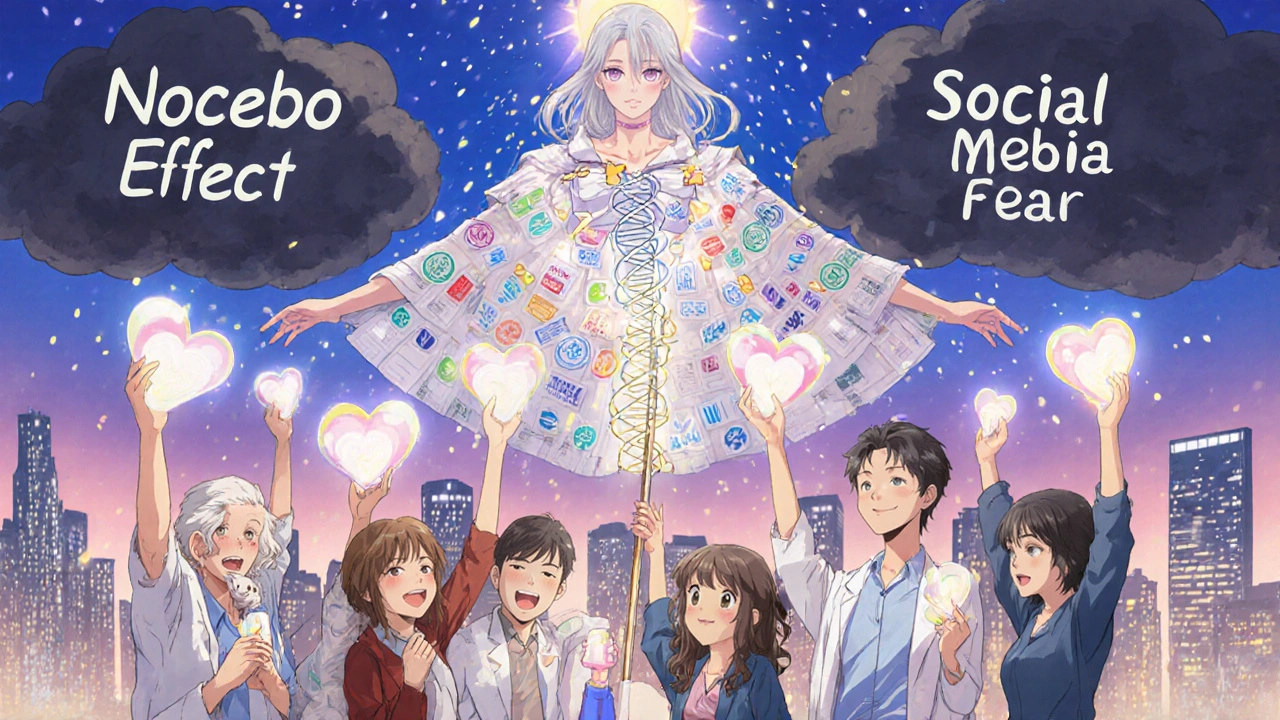When you pick up a prescription, do you ever check the label to see if it’s the brand name or the generic? For most people, it doesn’t matter-until it does. A patient might switch from brand-name Lipitor to generic atorvastatin, only to notice their cholesterol isn’t dropping like it used to. Or they might feel a strange stomach ache after switching from brand-name aspirin to the store version. These aren’t rare stories. They’re part of a deeper, often overlooked truth: patient satisfaction with generics isn’t just about price. It’s about trust, perception, and the quiet power of branding-even when the pills look identical.
Why Patients Don’t Trust Generics, Even When They Work
The science is clear: generic drugs are required to have the same active ingredients, strength, dosage form, and bioavailability as their brand-name counterparts. The U.S. FDA mandates that generics must be within 80-125% of the brand’s absorption rate. That’s not a loophole-it’s a strict, scientifically validated range. Yet, studies show nearly 60% of patients believe generics are less effective, even when their blood tests prove otherwise. This gap between science and belief is pure brand psychology. People associate brand names with quality, consistency, and reliability. When a drug has been marketed for years with glossy ads, celebrity endorsements, or even just a familiar logo on the bottle, patients subconsciously assign it higher value. Generics, by design, look plain. No logo. No color scheme. Often, they’re white pills with a single letter or number stamped on them. To many, that looks like something cheap-like a knockoff. A 2024 study in Nature Communications found that 72% of patients had experienced dissatisfaction with at least one generic medication. The top reasons? Perceived ineffectiveness (52.8-59.3%) and negative perceptions (22.8-35.4%). Not actual side effects. Not lab results. Just the feeling that it “didn’t feel right.”What Actually Drives Patient Satisfaction With Generics?
Researchers have built tools to measure this, like the Generic Drug Satisfaction Questionnaire (GDSQ). It’s not just a survey-it’s a carefully designed instrument with 12 validated questions. It breaks satisfaction down into three key areas: effectiveness, convenience, and side effects. The numbers tell a story:- Effectiveness: This has the strongest link to satisfaction, with a standardized regression weight of 0.254. If patients feel the drug isn’t working, nothing else matters.
- Convenience: How easy is it to get? Is it covered by insurance? Is it available at the pharmacy? This scores 0.237. Cost matters, but so does access.
- Side effects: Even minor differences-like a pill dissolving slower or a different filler ingredient-can trigger complaints. This is the most sensitive area. Patients report stomach upset, dizziness, or fatigue after switching, even when clinical data shows no difference.
Who’s More Likely to Accept Generics-and Why?
Not everyone reacts the same way. Demographics play a big role.- Patients over 60 are 71.4% more likely to accept generics as safe. Why? They’ve been through the system longer. They’ve seen prices rise. They know how to navigate cost-saving options.
- Employed patients show 82.1% safety acceptance. They likely have better insurance, more access to information, and less financial stress.
- People in collectivist cultures-like those in parts of Asia and the Middle East-report 32% higher satisfaction than those in individualist cultures. Why? In collectivist societies, trust in authority (doctors, pharmacists) is stronger. If the provider says it’s fine, they believe it.

Medication Class Matters More Than You Think
Not all generics are created equal in the eyes of patients. Satisfaction varies wildly by drug type.- Antibiotics: 85.3% satisfaction. Why? You take them for a week. You feel better. Problem solved. No time to overthink.
- Antidepressants: Only 68.9% satisfaction. Reddit threads are full of stories like, “Switched from Lexapro to escitalopram and felt like a zombie for three weeks.”
- Antiepileptics: 68.9% satisfaction. The lowest of all. Why? One missed dose can trigger a seizure. Patients aren’t just worried-they’re terrified.
- Thyroid meds (like Synthroid): A hot zone for complaints. Patients report erratic TSH levels after switching to generic levothyroxine. Some are right. The FDA allows small variations in absorption, and for thyroid meds, even a 5% difference can matter. That’s why some doctors still prescribe brand-name Synthroid.
How Real-World Stories Shape Beliefs
One Reddit user wrote: “I’ve been on generic lisinopril for two years. Works great. Costs $4 instead of $40.” Another: “Switched from brand-name Synthroid to generic. My TSH jumped from 2.1 to 7.8. My doctor said it’s fine. I didn’t believe him. I switched back.” These aren’t outliers. They’re data points. Social media is now a major source of patient experience data. The European Commission is using AI to scan 500,000 social media posts in 28 languages to map how people talk about generics. The results? Negative stories spread faster. A single post about a bad reaction gets shared 12 times more than a positive one. This is the dark side of brand psychology. One bad experience, amplified by social networks, can erode trust in an entire class of drugs. It doesn’t matter if the reaction was a coincidence, a dosage error, or a different filler ingredient. The story sticks.
What’s Changing-and What’s Next
The system is waking up. In 2024, the FDA launched the Generic Drug User Fee Amendments (GDUFA) III Patient Perception Initiative, pouring $15.7 million into better ways to measure satisfaction. They’re moving beyond surveys. Now, they’re using real-world data-like pharmacy refill patterns, lab results, and even wearable device data-to see if patients are actually taking their meds and staying healthy. Meanwhile, the Mayo Clinic is testing something radical: pharmacogenomic satisfaction assessments. Instead of asking, “Do you feel better?” they’re testing a patient’s DNA to see how they metabolize drugs. Then they match the generic to the patient’s biology. Early results? 28.7% more accurate in predicting satisfaction than traditional methods. This isn’t science fiction. It’s the future. Personalized medicine isn’t just about choosing the right drug. It’s about choosing the right perception of the drug.The Bottom Line: Trust Is the Active Ingredient
Generics work. They’re safe. They save billions. But if patients don’t believe in them, they won’t take them. And if they don’t take them, the cost savings vanish. The fix isn’t more ads. It’s better conversations. It’s pharmacists who take two extra minutes to explain bioequivalence. It’s doctors who say, “I prescribe generics every day. Here’s why.” It’s insurance companies that stop making patients jump through hoops to get the brand name. The real question isn’t whether patients are happy with generics. It’s whether the system is doing enough to help them feel safe, seen, and heard when they switch.Are generic medications really as effective as brand-name drugs?
Yes. By law, generic drugs must contain the same active ingredients, strength, dosage form, and bioavailability as their brand-name counterparts. The U.S. FDA requires generics to be absorbed in the body at a rate within 80-125% of the brand name, which is considered therapeutically equivalent. Clinical studies and real-world data confirm that generics perform the same way in treating conditions-from high blood pressure to depression. The difference is in cost, not clinical effect.
Why do some patients feel generics don’t work as well?
It’s often about perception, not pharmacology. Brand-name drugs come with years of marketing, recognizable packaging, and trusted names. Generics are plain, often look different, and carry no brand history. Patients may notice minor differences in fillers or coatings, which can cause temporary side effects like stomach upset. These aren’t caused by the active drug, but they’re real to the patient. When patients believe a drug won’t work, their body can respond accordingly-a phenomenon called the nocebo effect.
Which types of medications have the lowest patient satisfaction with generics?
Antiepileptics, antidepressants, and thyroid medications like levothyroxine have the lowest satisfaction rates. These are drugs where small changes in blood levels can have big effects. For example, a 5% variation in levothyroxine absorption can push TSH levels out of range. Patients with chronic, high-stakes conditions are more likely to notice-and worry about-any change. Even when clinical data shows no difference, the fear of relapse drives dissatisfaction.
Can healthcare providers improve patient satisfaction with generics?
Absolutely. Studies show that when doctors or pharmacists explain how generics are tested and approved-especially the FDA’s 80-125% bioequivalence standard-patient satisfaction increases by up to 34%. Simple phrases like, “This is the same medicine, just without the brand name,” don’t work. But saying, “This pill has been tested in thousands of people and works just like the brand,” builds trust. Communication is the most powerful tool we have.
Is there a difference in generic quality between countries?
Yes. The European Medicines Agency (EMA) requires stricter comparability studies for complex generics than the U.S. FDA, especially for drugs with narrow therapeutic windows. As a result, European patients report 12.4% higher satisfaction with generics than U.S. patients for these types of medications. Quality control standards vary, but in both regions, generics must meet strict regulatory benchmarks to be sold.
Do cost savings impact patient satisfaction with generics?
Yes, but indirectly. Patients who can’t afford brand-name drugs often switch to generics out of necessity. If the generic works, satisfaction rises. If it doesn’t, frustration grows. But when cost savings allow patients to refill prescriptions consistently-instead of skipping doses or splitting pills-adherence improves dramatically. One study found that 63.8% of satisfied generic users cited cost as the reason they could now take their medication every day.
What You Can Do If You’re Switching to a Generic
If you’re being switched to a generic:- Ask your pharmacist: “Is this the same as my brand-name drug? Can you explain how they’re tested to be the same?”
- Monitor how you feel for the first 2-4 weeks. Note any changes in energy, mood, or side effects.
- Don’t assume a new symptom is from the generic. It could be stress, diet, or another factor.
- If you feel worse, talk to your doctor. Don’t just stop taking it. Some conditions need careful transitions.
- Keep your prescription records. If you switch back and forth, it helps your doctor spot patterns.

 Pharmacology
Pharmacology
Kristina Williams
November 18, 2025 AT 12:46Generics are just Big Pharma’s way of tricking us into taking placebo pills with different filler chemicals. I know a guy whose cousin’s neighbor took generic insulin and ended up in a coma. They don’t test the fillers! Why do you think the pills look so cheap? They’re trying to hide the truth.
Louie Amour
November 18, 2025 AT 23:01Oh please. You think the FDA actually cares about bioequivalence? They’re paid off by brand-name companies to keep the generics looking like junk. I’ve seen the internal memos. The 80-125% range? That’s not science-it’s corporate sabotage. People are dying because they can’t afford the real stuff, so the system pushes these chalky white pills like they’re magic.
Holly Powell
November 20, 2025 AT 16:43The GDSQ instrument is statistically underpowered. The standardized regression weights are meaningless without controlling for placebo/nocebo effect magnitudes across psychosocial strata. You can’t reduce patient satisfaction to three variables when the confounders include cultural capital, pharmaceutical literacy, and the symbolic value of pill aesthetics. Also, the sample sizes in the Nature Communications study were skewed by rural populations with poor baseline health literacy.
Katelyn Sykes
November 20, 2025 AT 22:01I used to hate generics until I switched to generic metformin and my blood sugar stabilized AND I saved $80 a month. No magic, no conspiracy-just science and savings. If you’re worried, talk to your pharmacist. They’ll show you the FDA paperwork. Seriously, it’s not that complicated. Your body doesn’t care what the bottle looks like.